|
An ancient and noble breed
rarely seen in the ring...
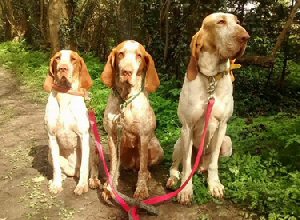 Anne
Brierley has owned a Bracco Italiano since 2002. They are a rare breed of dog in
this country and were even rarer in 2002. She was first introduced to the breed
at Discover Dogs and fell in love with them immediately. As they are high energy
dogs that need to be well exercised and their minds kept occupied, Anne thought of
doing Agility with them. Well, why not... Anne
Brierley has owned a Bracco Italiano since 2002. They are a rare breed of dog in
this country and were even rarer in 2002. She was first introduced to the breed
at Discover Dogs and fell in love with them immediately. As they are high energy
dogs that need to be well exercised and their minds kept occupied, Anne thought of
doing Agility with them. Well, why not...
An interview with the Bracc Pack
Branco Italianos are HPR (hunt, point,
retrieve) Gundogs and, as you can see, they are the most hound-like of the
gundog breeds. Though they can be nervous with people and dogs from an early
age, as long as they are socialised well, they are great companions and family
pets as well as working dogs.
The Breed
As a breed they can be 'tricky' to train whether it be in general obedience,
gundog training and / or agility. I
refrain from using the word 'difficult' as it wouldn't be a true reflection of the
character of the breed. They do not respond well to negative handling. However
they do need to understand boundaries. This is achieved by consistency and
positive reinforcement. This can include, praise, reward, play or a toy
depending on the individual personality of the dog and what their drive is. The
most important thing in training this breed is clear, consistent, firm but
careful handling is required.
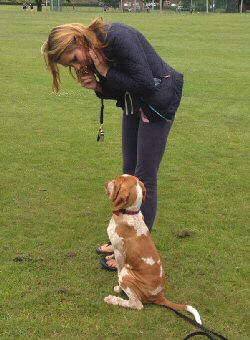 There will be
times when progress seems to be going forward. Then the next time the same
exercise is repeated, you are back to the 'square one' so large amounts of
patience, as well as perseverance and a sense of humour are vital for success. There will be
times when progress seems to be going forward. Then the next time the same
exercise is repeated, you are back to the 'square one' so large amounts of
patience, as well as perseverance and a sense of humour are vital for success.
The hound and the hunt instinct in the breed can dominate which means
that they can be easily distracted by their surroundings. They are an intelligent breed but, at
times, this can be overshadowed by comical behaviour, which they use often to
take advantage of a situation!
My Braccos
I currently have three Bracco Italiano -
Ettie age 5, Bertie age 4 and Millie age 3. All do agility to varying levels.
Each dog's personality is unique as is the way they work and their motivation.
Ettie, for instance, has a strong work ethic and wants to do
it right. She is very vocal at agility and can think she knows better than the
handler. On occasions when handler error creates an opportunity, she believes
she knows best and will take matters into her own hands. She can also argue her
point and be stubborn if there is something she objects to doing or there is an
alternative, higher rewarding opportunity, such as wild life.
Ettie
responds well to praise, food reward and will play with a tug toy. I use key
words like 'listen' before starting a course, so as she understands what is
now expected of her. She loves agility, life and people, but takes her work very
seriously. Ettie has been successful at winning out of Grade 1 and 2. Hence, we are now
all Grade 3.
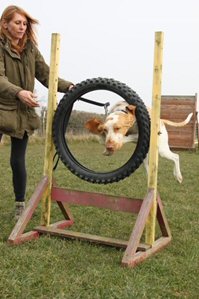 Bertie puts a smile on everyone's face. He
loves life to the full even though, when we first brought him home at age five
months, he was terrified of everything. Now his tail wags continuously and he
has a very cheeky streak to his personality. He responds well to praise and food, but does
require persistent reminders to keep him focused. We have yet to achieve
complete course - let alone a clear round - as his nose will carry him off to
hunt for birds, food or undesirable substances. He loves the day out, but
still has yet to learn that he might actually have to listen as well. Bertie puts a smile on everyone's face. He
loves life to the full even though, when we first brought him home at age five
months, he was terrified of everything. Now his tail wags continuously and he
has a very cheeky streak to his personality. He responds well to praise and food, but does
require persistent reminders to keep him focused. We have yet to achieve
complete course - let alone a clear round - as his nose will carry him off to
hunt for birds, food or undesirable substances. He loves the day out, but
still has yet to learn that he might actually have to listen as well.
Millie is a very sweet girl. She just wants
to please everyone and keep the peace! At competitions, she gets very excited at
competitions and sometimes cannot hold back her excitement, especially for
tunnels. She tries very hard to get it right and please her handler.
She
is very food focused, so this is her main reward as well as praise. Millie can
get very unsure even with the slightest of raised voice or furrowed brow, so
handling needs to be positive. Like the other two, her nose can get the better of
her, but most of her excursions out of the ring will be to visit her family. She has won rosettes and, when she goes well.
she has beaten Ettie.
Starting agility
I have always been interested in agility and had wanted to try the sport with
Buttercup, my first Bracco. Unfortunately, children, husband and life in general
took over, but she was an amazing family pet.
After
Buttercup passed away, we were blessed with Ettie who demonstrated how
much energy a Bracco can have! At this point, I decided that I needed to
harness this energy, so I embarked on finding an agility club that could
help me channel her enthusiasm for life.
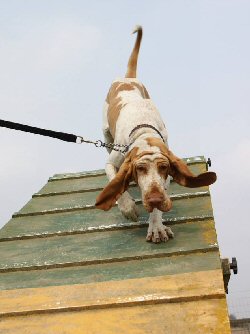 I
discovered CKT Agility on-line in my search for a local club. It was only 10
minutes drive away, so ideal. Initially I had some 1-2-1 lessons with the
trainer Kate Truluck with Ettie and was soon able to join a class. Kate welcomes
all breeds of dogs and helps with all aspect of dog handling> I found the club
is very friendly and the members are equally helpful. Everyone I've met has been
supportive and sociable. The club holds regular social events organised by it's
members, not just to talk about which shows to attend but also so members can
get to know each other. I felt right at home. I
discovered CKT Agility on-line in my search for a local club. It was only 10
minutes drive away, so ideal. Initially I had some 1-2-1 lessons with the
trainer Kate Truluck with Ettie and was soon able to join a class. Kate welcomes
all breeds of dogs and helps with all aspect of dog handling> I found the club
is very friendly and the members are equally helpful. Everyone I've met has been
supportive and sociable. The club holds regular social events organised by it's
members, not just to talk about which shows to attend but also so members can
get to know each other. I felt right at home.
Then I got the courage to approach Kate about Bertie. At the time, he was
extremely nervous and would often bark at strangers, particularly people in hats
of any kind. He would also back away if approached by a person. Again we started
with private sessions. Kate embraced his nervousness and when he moved to a
group, everyone was encouraged to give him a treat so that he realised people
were not so frightening. He is now happy around people and all environments.
Millie then joined the family as a puppy.
Training issues
By far the Bracco's greatest problem at agility is their sense of
smell and hunting instinct. All three dogs have, at one time or another, run off
hunting, seeking out undesirable substances for eating. This is a problem at
both outdoor and indoor venues.
The indoor venues I have been to tend to be
equestrian centres and, although cleared of horse manure, there are often
remnants of this left behind. If so, the Braccos will find the tiniest amount.
We have been able to address this issue in class to some extent as we train at
such venues. To help with this, Kate will often chase the dog away from the
manure and I will recall and reward. This has helped a lot and only rarely does
Ettie run off now. Millie does on occasion and Bertie still has a tendency to
follow his nose. This is improving.
Outdoor venues have the additional issue of
wild life. A Bracco can pick up on their scent from some distance and it has
been known for them to leave a ring on the trail of a scent. I have worked
really hard on recall with praise and food reward, for this in particular. I
will always praise on their return regardless of the misdemeanour, as this
encourages them to return. Fortunately they have never wandered too far.
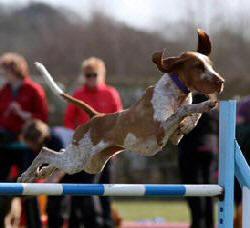 Bertie
also likes to do a lap of honour in class and say 'hello' to people, funnily
enough, and other dogs. This we have attempted to combat by asking people to
'shoo' him away. Again this is improving but is a work in progress.
Perseverance, consistency and patience are imperative! Bertie
also likes to do a lap of honour in class and say 'hello' to people, funnily
enough, and other dogs. This we have attempted to combat by asking people to
'shoo' him away. Again this is improving but is a work in progress.
Perseverance, consistency and patience are imperative!
Another issue with Braccos is the height they jump, in particular with Millie.
We are working on this by using different handling techniques, timing the call
of a turn early enough and grid work. These are ongoing issues and, in time, I
am confident that they will be resolved with the usual perseverance.
As for agility shows, we are always made to
feel welcomed. We attend both KC registered shows and non-affiliated shows. The
Bracco Italiano is such an unusual breed of dog, and as yet, I have not seen
anyone else competing with them.
We are often asked what breed of dog they are and, when they see them run the
courses, they are pleasantly surprised. The non-affiliated shows are more
relaxed, with a more different breed of dog and participants who are there 'just
for fun!' This does not mean, however, that the courses are easier, sometimes
they can be harder! But ultimately it depends who sets the course.
Both have their benefits. Obviously at a Kennel Club show, if you win, there is
the opportunity to move up a grade but these are much more competitive. At the
non-affiliated, there is more a sense of a fun day out.
Now
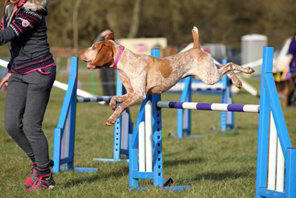 Now
we have achieved the great heights of Grade 3, it is a challenge to see if we
can move up. Both Ettie and Millie have been placed, with Ettie achieving a 3rd
place at Grade 3 but, at this level, there are a large number of dogs in each
class. Beating the collies at their sport is going to be difficult. However, I
am up for a challenge and will endeavour to work hard on timing and handling of
my dogs in an attempt to get to Grade 4. I will also consider progressing
through the Agility Warrant scheme but, at present, I am happy to continue as I
am throughout the summer, and I will make a decision as to how I will progress
at the end of this year. Now
we have achieved the great heights of Grade 3, it is a challenge to see if we
can move up. Both Ettie and Millie have been placed, with Ettie achieving a 3rd
place at Grade 3 but, at this level, there are a large number of dogs in each
class. Beating the collies at their sport is going to be difficult. However, I
am up for a challenge and will endeavour to work hard on timing and handling of
my dogs in an attempt to get to Grade 4. I will also consider progressing
through the Agility Warrant scheme but, at present, I am happy to continue as I
am throughout the summer, and I will make a decision as to how I will progress
at the end of this year.
Braccos give me - and everyone that knows
them - much pleasure, whether it goes well or not. The experience is always
positive, and it shows that through consistency, perseverance, dedication,
commitment, patience and love, these dogs can work very well.
It would be great to have some company from
fellow Bracco lovers!
About the author...
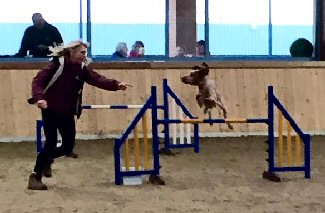 Anne Brierley
grew up with dogs and cats in her life including Yorkshire Terriers, Spaniels
and a Labrador X - not all at once, but over the years. They were purely pets,
badly trained and always loved. Anne Brierley
grew up with dogs and cats in her life including Yorkshire Terriers, Spaniels
and a Labrador X - not all at once, but over the years. They were purely pets,
badly trained and always loved.
It wasn't until she got married and had
children of her own did she got her first dog - a Bernese Mountain Dog called
Bovis, who was just a family pet with little training.
Next came Samson, a Newfoundland, and his
name reflected his size. He was big even for a Newfoundland. He was a protective
dominant dog and Anne had a steep learning curve in dog training techniques from
a specialist dog behaviourist. It was Samson who made her realise the importance
of dog training from an early age. Tom, a Papillion, was Samson's companion and
great mate.
In 2002, along came Buttercup, her first
Bracco Italiano followed by Little Em, a bloodhound. Of course, she made sure
both dogs were well socialised and trained to a basic level for family life.
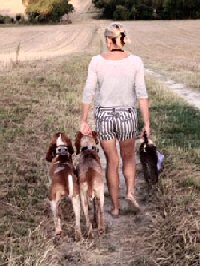 After
Buttercup passed away in 2011, Anne realised she couldn't live without a Bracco,
so Ettie arrived. She was a bundle of energy. Ettie was enrolled on puppy
training classes, and went on to get her KC Good Citizen Bronze and Silver
awards. As she grew, it was clear that her energy needed to be channelled into
some form of structured exercise, so so they began some gundog training and
agility. After
Buttercup passed away in 2011, Anne realised she couldn't live without a Bracco,
so Ettie arrived. She was a bundle of energy. Ettie was enrolled on puppy
training classes, and went on to get her KC Good Citizen Bronze and Silver
awards. As she grew, it was clear that her energy needed to be channelled into
some form of structured exercise, so so they began some gundog training and
agility.
Shortly after Buttercup died, Em passed away.
Bertie then arrived on the scene - five months old, poorly socialised and
terrified of everything. Now he loves life to the full. It was a challenge but
continuous efforts paid off. He too loves Agility.
Then along came Millie, a tiny puppy, with a
sweet nature. She is still small and sweet. She too loves Agility and also does
gun dog training.
Anne also has two other dogs - Gunner a
Working Cocker and Bomber, a Chihuahua X. They also do Agilty. She has found
that Agility with the dogs creates a closer bond through the pleasure they get
from it and the partnership it creates through working together.
First published 9 May 2016
T |